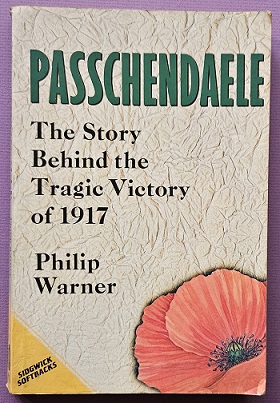Description
Title: Passchendaele – The Story Behind the Tragic Victory of 1917
Author: Warner, Philip
Condition: Very Good Plus
Edition: 3rd Edition
Publication Date: 1989
ISBN: 0283997451
Cover: Soft Cover without Dust Jacket – 289 pages
Comments: An in-depth account about the carnage on the Western Front at Passchendaele, where 275,000 Allied soldiers and 200,000 German soldiers fell.
The Battle of Passchendaele, fought July 1917, is sometimes called the Third Battle of Ypres. For the soldiers who fought at Passchendaele, it was known as the ‘Battle of Mud’. Few battles encapsulate World War One better than the Battle of Passchendaele.
The attack at Passchendaele was Sir Douglas Haig’s attempt to break through Flanders. Haig had thought about a similar attack in 1916, but the Battle of the Somme occupied his time in that year. However, one year later, Haig felt able to launch such an attack. His main aim was a breakthrough to the coast of Belgium so that German submarine pens could be destroyed. Admiral Jellicoe had already advised both Haig and the British government that the loss of shipping (primarily merchant) could not be sustained and that Britain would face severe problems in 1918, if such losses continued. Haig’s plan, to sweep through Flanders to the coast, did not receive support from Britain’s Prime Minister, David Lloyd George, but as the Allies had no other credible plan, he gave his agreement for Haig to carry out his plan.
Haig also had another reason for going ahead with his plan. He believed, incorrectly as it turned out, that the morale of the German army was very low – especially after the success of the Allies at the Battle of Messines. He believed that the Allies could tap into this lack of morale and roll through Flanders without too much trouble.
On July 18th, 1917, a heavy artillery barrage was launched at the German lines. This lasted for ten days. Three thousand artillery guns fired over four million shells. Therefore, the German army in the area fully expected a major Allied attack – so any vague hope of surprise was lost, as was true in any attack that started with a major artillery bombardment.
The infantry attack started on July 31st. The main assault was led by Sir Hubert Gough’s Fifth Army. To their left were units from the French First Army led by Anthoine and to Gough’s right was the Second Army led by the victor of Messines, Sir Herbert Plumer.
The Germans, as happened at the Somme, were fully prepared and the Allied attack, launched across an eleven-mile front, made only small gains. Then in the early days of August, the area was saturated with the heaviest rain the region had seen in thirty years. The area in Flanders became effectively a swamp. Tanks, sent forward to help the infantry, simply got stuck. Infantry soldiers found movement very difficult. The impact of the artillery bombardment had destroyed the drainage systems of the region which greatly added to the problem. The shell craters made by the Allied shelling filled with water and did not allow advancing men the opportunity to hide in them. The fields through which men should have gone became impassable.
Haig blamed the lack of progress not on the abnormal weather and the conditions it caused, but on Gough. Haig moved Gough and his men to a front further north and put Plumer in charge of the battle. Plumer used different tactics to Gough. He wanted small gains that could be permanently held as opposed to Gough’s apparent desire for one major sweeping movement that would bring success. As a result, Plumer fought a series of small battles within Flanders – the Battle of Menin Road Bridge, the Battle of Polygon Wood and the Battle of Broodseinde. These were fought between September and October 1917. These gave British forces the advantage in the territory to the east of Ypres. Haig became convinced that German morale was on the verge of collapsing and ordered that the offensive be continued to Passchendaele Ridge.
Between October 9th and October 12th, two battles were fought – Poelcappelle and the First Battle of Passchendaele. By now, those German soldiers who had been fighting on the Eastern Front had been moved to the Western Front – and they had been specifically moved to Passchendaele Ridge to bolster the German forces there. The Germans used mustard gas to assist them and the attempted Allied breakthrough to Passchendaele Ridge failed to materialise. However, Haig would not concede that the attack had not succeeded. In late October three further, Allied attacks were made on Passchendaele Ridge. On November 6th, 1917, Passchendaele village was taken, and Haig used this success as the reason for calling off the attack.
However, the Third Battle of Ypres or Passchendaele had been a very costly battle. For the sake of a few kilometres, the British had lost 310,000 men and the Germans 260,000. Haig was heavily criticised for the attack and for failing to modify his plans as the attack clearly was not going to be a success. There were some who rallied to Haig’s defence. They argued that:
Haig could not have known that the weather would have played such a major part in the battle.
The input of the newly arrived German troops from the Eastern Front was not part of Haig’s planning and nor could it have been.
The dangers of German submarine activity had to be eliminated whatever the risk.
A British success would have gone someway to improving the morale of the French army that had mutinied in that year – an ally supporting an ally.
Haig argued that any German loss of men was of greater importance than British loss as the Allies could sustain more losses as America had joined the war by the end of Passchendaele.




